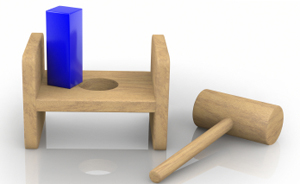
Round peg in square hole or square peg in round hole?

Which gives a tighter fit: a square peg in a round hole or a round peg in a square hole?
This puzzle was contributed by Colm Mulcahy, Associate Professor of Mathematics at Spelman College in Atlanta, Georgia. Colm's own puzzles have appeared in Math Horizons and in the New York Times. He is a long-time columnist for the Mathematical Association of America and has his own blog. You can follow Colm on Twitter.
Solution link
Anonymous
As a generalization, is the same true for any regular n-gon, as opposed to the square, when you look at the inscribed and circumscribed circles and what is the limiting behaviour?
AW
Anonymous
So it looks like the round peg in square hole is tighter since:
Assume radius =1
Area of circle = pie(r)^2 = 3.14159
Are of square = 4x (1*1)=4
Ratio = 3.14159/4 = .78
while square peg in round hole is:
Area of square = 4*(1/2 base*height)=4*(1/2*1*1) = 2
Area of circle = pie(r)^2 = 3.14159
ratio = 2/3.14159 = .63
JV
Anonymous
What do you mean by tighter fit?
Jack
So which one wastes less space
Anonymous
Until the clearances are within .001 inch.
Anonymous
It gets even more interesting when you generalize this problem to more than two dimensions!
(i.e. cubes-in-spheres/spheres-in-cubes and their higher dimensional equivalents). Which is the better fit
changes above 8 dimensions (Roughly speaking as you increase the number of dimensions, more and more of the volume of the hypercube is out near its corners - high dimension cubes are qualitatively more like hedgehogs than building blocks! )
gnanasenthil
In both the cases the area of contact is going to the same, so how does one be a tighter fit over the other
Anonymous
the hole made by the extra area
Anonymous
round peg in square hole is easy
assume side of square is 2
A-circle=3.1415926.... (pi*1^2)
A-square=4 (2^2)
A.C/A.S=.7354
square in circle is slightly harder
diameter circle=2
A-circle=3.14159...
A-square=sqrt.2^2=2
2/3.14...=.63662
round peg is tighter fit
Anonymous
A.C/A.S=0.7854 (vice 0.7354); doesn't change the conclusion, though.
Anonymous
A piece of one inch diameter dowel rod one inch long, can be fitted closely into a one inch square hole
Anonymous
You can do even better and make a shape that fits perfectly in a square hole, round hole and triangular hole. See this clip for the excellent TV show QI
http://www.youtube.com/watch?v=6fUplOcay7E
Anonymous
One inch DIAMETER. 1x1 = 1. You're treating radius and diameter as exactly the same entity. a square 1x1, of course a one inch diameter will fit into it. Also, length does not matter!
Anonymous
For round peg in square hole-
P = pi x 5 x 5 = 25pi
H = 5 x 5= 25
P : H = pi : 1
__________________________
For square peg in round hole-
P = 5 x 5 = 25
H = 5 x 5 x pi= 25pi
P : H = 1 : pi
________________________________
Clearly ratio of P : H is greater in 1st case, so the best fit would be the first one.
-Ajay Porwal
Anonymous
but for the round peg to fit in the square hole the radius must be half the side length
and the square in round hole the side length of the square is sqrt.(2) less than the round hole
Anonymous
As a carpenter, I know the REAL solution to this problem from a more practical point of view.
Dress the corners on one end of your square dowel and drive the peg in the hole.
The edges of the hole will shear off the remaining edges of the square dowel.
If you're actually doing this somewhere besides a sheet of paper, you will find that
drilling a round hole is much easier than trying to chisel out a square one.
As a side note, make sure that your dowel stock is kiln dried and it will stay tight for years to come.
Anonymous
I've found this very useful, never thought of drilling a square hole
Anonymous
I think it should be about the relation between diameter(D) and square side (x).
(1.) Square Peg in a Round Hole
To fit in, Diameter (D) = x sqrt (2)
(2.) Round Peg in a Square Hole
To fit in, Diameter (D) = x
So, (2) shall be tighter than (1) since square peg required less diameter hole to fit in (which is D/sqrt(2)).
Anonymous
Squares within circles within squares give some interesting possibilities. See my http://seekecho.blogspot.co.uk/2011/12/same-area.html
Anonymous
Now try this for 3 dimensions: cube in sphere or sphere in cube. Solve that and try it in 4D! :)
Anonymous
The tighter fit would be the square peg in the round hole, because the circle hole is smaller than the square hole, so when you put the square peg into the circle hole it would just fit in, because the circle is round and the square peg is not.
Anonymous
To hold permanently a tenon that fits into a mortise in a chair (where there is much flexing) use a peg that goes through both.
A square piece of wood that is the same size (across flats) as the diameter of the hole is rounded off on one end - one end cylindrical, one end rectangular.
The round part slips into the round hole. A mallet is used to drive it in the rest of the way.
It will NEVER loosen up.
enchanted wombat
I think that it depends on how big the circle and square are. =D